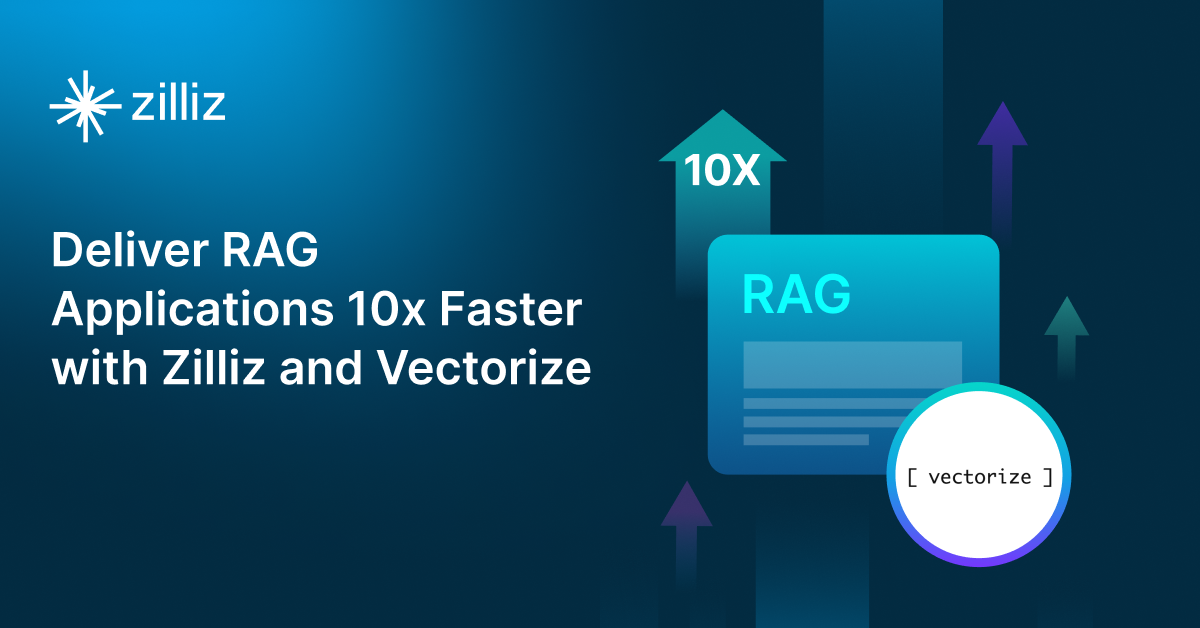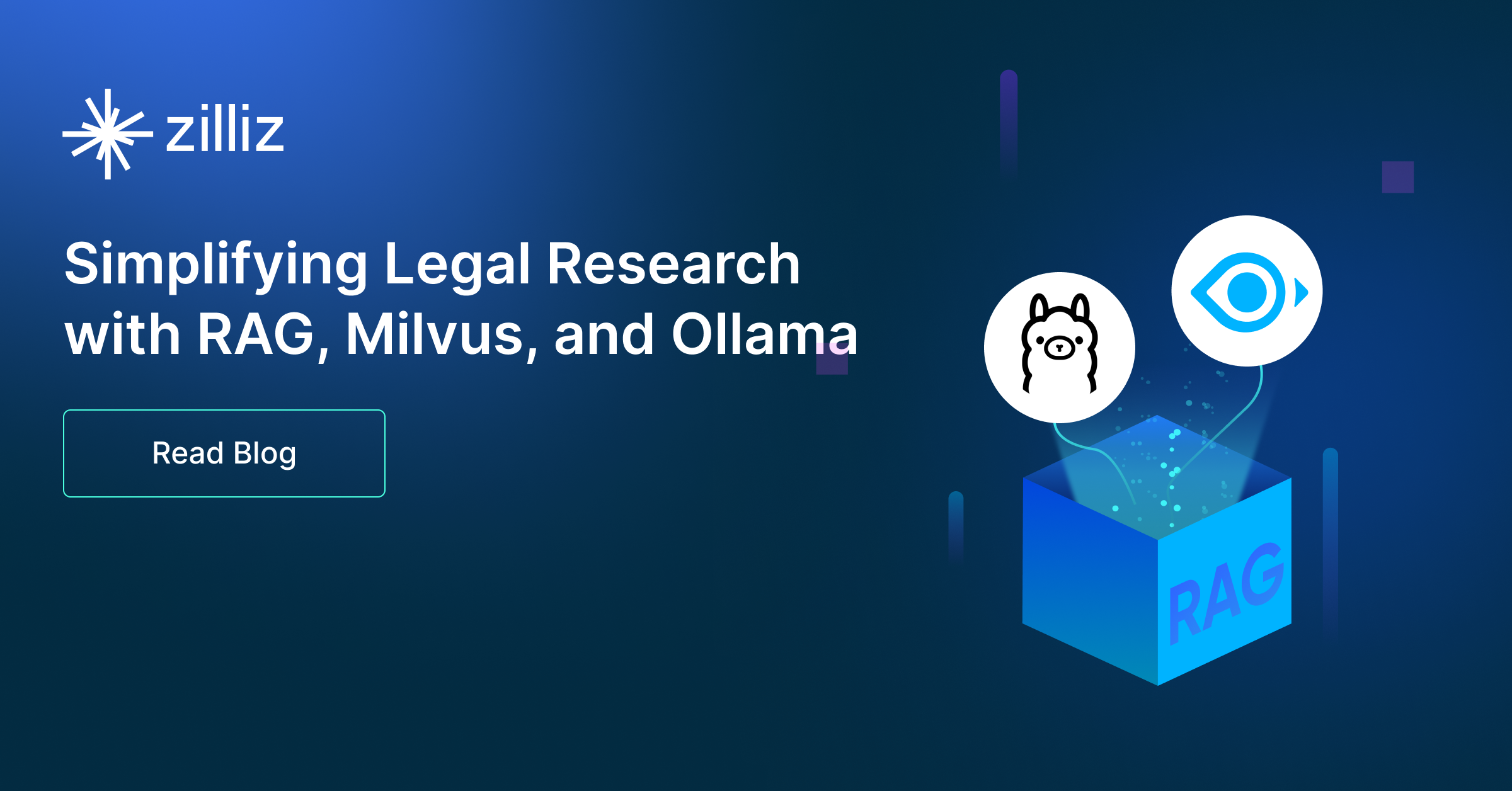Build RAG Chatbot with LangChain, Zilliz Cloud, Mistral AI Mistral 7B, and OpenAI text-embedding-ada-002
Introduction to RAG
Retrieval-Augmented Generation (RAG) is a game-changer for GenAI applications, especially in conversational AI. It combines the power of pre-trained large language models (LLMs) like OpenAI’s GPT with external knowledge sources stored in vector databases such as Milvus and Zilliz Cloud, allowing for more accurate, contextually relevant, and up-to-date response generation. A RAG pipeline usually consists of four basic components: a vector database, an embedding model, an LLM, and a framework.
Key Components We'll Use for This RAG Chatbot
This tutorial shows you how to build a simple RAG chatbot in Python using the following components:
- LangChain: An open-source framework that helps you orchestrate the interaction between LLMs, vector stores, embedding models, etc, making it easier to integrate a RAG pipeline.
- Zilliz Cloud: a fully managed vector database-as-a-service platform built on top of the open-source Milvus, designed to handle high-performance vector data processing at scale. It enables organizations to efficiently store, search, and analyze large volumes of unstructured data, such as text, images, or audio, by leveraging advanced vector search technology. It offers a free tier supporting up to 1 million vectors.
- Mistral AI's Mistral 7B: A highly efficient and powerful language model with 7 billion parameters. It is designed to offer robust performance for a wide range of natural language processing tasks, delivering high-quality responses while maintaining a balance between speed and computational resource usage. Its architecture is optimized for both flexibility and scalability in AI applications.
- OpenAI text-embedding-ada-002: This model specializes in generating high-quality text embeddings, providing a powerful tool for various NLP applications. Its strengths lie in semantic search, clustering, and recommendation tasks. Ideal for developers needing efficient and scalable solutions for understanding and processing natural language data in diverse contexts.
By the end of this tutorial, you’ll have a functional chatbot capable of answering questions based on a custom knowledge base.
Note: Since we may use proprietary models in our tutorials, make sure you have the required API key beforehand.
Step 1: Install and Set Up LangChain
%pip install --quiet --upgrade langchain-text-splitters langchain-community langgraph
Step 2: Install and Set Up Mistral AI Mistral 7B
pip install -qU "langchain[mistralai]"
import getpass
import os
if not os.environ.get("MISTRAL_API_KEY"):
os.environ["MISTRAL_API_KEY"] = getpass.getpass("Enter API key for Mistral AI: ")
from langchain.chat_models import init_chat_model
llm = init_chat_model("open-mistral-7b", model_provider="mistralai")
Step 3: Install and Set Up OpenAI text-embedding-ada-002
pip install -qU langchain-openai
import getpass
import os
if not os.environ.get("OPENAI_API_KEY"):
os.environ["OPENAI_API_KEY"] = getpass.getpass("Enter API key for OpenAI: ")
from langchain_openai import OpenAIEmbeddings
embeddings = OpenAIEmbeddings(model="text-embedding-ada-002")
Step 4: Install and Set Up Zilliz Cloud
pip install -qU langchain-milvus
from langchain_milvus import Zilliz
vector_store = Zilliz(
embedding_function=embeddings,
connection_args={
"uri": ZILLIZ_CLOUD_URI,
"token": ZILLIZ_CLOUD_TOKEN,
},
)
Step 5: Build a RAG Chatbot
Now that you’ve set up all components, let’s start to build a simple chatbot. We’ll use the Milvus introduction doc as a private knowledge base. You can replace it with your own dataset to customize your RAG chatbot.
import bs4
from langchain import hub
from langchain_community.document_loaders import WebBaseLoader
from langchain_core.documents import Document
from langchain_text_splitters import RecursiveCharacterTextSplitter
from langgraph.graph import START, StateGraph
from typing_extensions import List, TypedDict
# Load and chunk contents of the blog
loader = WebBaseLoader(
web_paths=("https://milvus.io/docs/overview.md",),
bs_kwargs=dict(
parse_only=bs4.SoupStrainer(
class_=("doc-style doc-post-content")
)
),
)
docs = loader.load()
text_splitter = RecursiveCharacterTextSplitter(chunk_size=1000, chunk_overlap=200)
all_splits = text_splitter.split_documents(docs)
# Index chunks
_ = vector_store.add_documents(documents=all_splits)
# Define prompt for question-answering
prompt = hub.pull("rlm/rag-prompt")
# Define state for application
class State(TypedDict):
question: str
context: List[Document]
answer: str
# Define application steps
def retrieve(state: State):
retrieved_docs = vector_store.similarity_search(state["question"])
return {"context": retrieved_docs}
def generate(state: State):
docs_content = "\n\n".join(doc.page_content for doc in state["context"])
messages = prompt.invoke({"question": state["question"], "context": docs_content})
response = llm.invoke(messages)
return {"answer": response.content}
# Compile application and test
graph_builder = StateGraph(State).add_sequence([retrieve, generate])
graph_builder.add_edge(START, "retrieve")
graph = graph_builder.compile()
Test the Chatbot
Yeah! You've built your own chatbot. Let's ask the chatbot a question.
response = graph.invoke({"question": "What data types does Milvus support?"})
print(response["answer"])
Example Output
Milvus supports various data types including sparse vectors, binary vectors, JSON, and arrays. Additionally, it handles common numerical and character types, making it versatile for different data modeling needs. This allows users to manage unstructured or multi-modal data efficiently.
Optimization Tips
As you build your RAG system, optimization is key to ensuring peak performance and efficiency. While setting up the components is an essential first step, fine-tuning each one will help you create a solution that works even better and scales seamlessly. In this section, we’ll share some practical tips for optimizing all these components, giving you the edge to build smarter, faster, and more responsive RAG applications.
LangChain optimization tips
To optimize LangChain, focus on minimizing redundant operations in your workflow by structuring your chains and agents efficiently. Use caching to avoid repeated computations, speeding up your system, and experiment with modular design to ensure that components like models or databases can be easily swapped out. This will provide both flexibility and efficiency, allowing you to quickly scale your system without unnecessary delays or complications.
Zilliz Cloud optimization tips
Optimizing Zilliz Cloud for a RAG system involves efficient index selection, query tuning, and resource management. Use Hierarchical Navigable Small World (HNSW) indexing for high-speed, approximate nearest neighbor search while balancing recall and efficiency. Fine-tune ef_construction and M parameters based on your dataset size and query workload to optimize search accuracy and latency. Enable dynamic scaling to handle fluctuating workloads efficiently, ensuring smooth performance under varying query loads. Implement data partitioning to improve retrieval speed by grouping related data, reducing unnecessary comparisons. Regularly update and optimize embeddings to keep results relevant, particularly when dealing with evolving datasets. Use hybrid search techniques, such as combining vector and keyword search, to improve response quality. Monitor system metrics in Zilliz Cloud’s dashboard and adjust configurations accordingly to maintain low-latency, high-throughput performance.
Mistral AI Mistral 7B optimization tips
Mistral 7B is a dense transformer-based model optimized for efficiency, making it a strong choice for RAG applications with constrained resources. Improve retrieval by using high-quality embeddings and reranking strategies to ensure only the most relevant documents are included in the context window. Optimize token usage by structuring input prompts concisely, eliminating redundant details while preserving key information. Use temperature (0.1–0.3) for consistent factual accuracy and adjust sampling techniques based on the required response diversity. Deploy Mistral 7B in a scalable infrastructure by leveraging quantization techniques (such as 4-bit or 8-bit precision) to improve inference speed without significantly impacting accuracy. Implement batch processing for handling multiple queries efficiently, reducing overall computational load. When working in real-time applications, consider response caching to minimize redundant API calls.
OpenAI text-embedding-ada-002 optimization tips
OpenAI text-embedding-ada-002 is widely used for its balance between performance and cost efficiency. Optimize retrieval by segmenting long documents into smaller, meaningful chunks before embedding, ensuring better contextual alignment with queries. Implement vector quantization to reduce memory footprint if handling large-scale embeddings. Use multi-stage retrieval, where an initial ANN search is followed by a more precise filtering or re-ranking step. Adjust index refresh frequency based on data update cycles to maintain relevance without excessive compute overhead. Leverage batching for embedding operations to minimize API latency. Consider fallback mechanisms, such as keyword-based retrieval, for edge cases where dense search alone may fail.
By implementing these tips across your components, you'll be able to enhance the performance and functionality of your RAG system, ensuring it’s optimized for both speed and accuracy. Keep testing, iterating, and refining your setup to stay ahead in the ever-evolving world of AI development.
RAG Cost Calculator: A Free Tool to Calculate Your Cost in Seconds
Estimating the cost of a Retrieval-Augmented Generation (RAG) pipeline involves analyzing expenses across vector storage, compute resources, and API usage. Key cost drivers include vector database queries, embedding generation, and LLM inference.
RAG Cost Calculator is a free tool that quickly estimates the cost of building a RAG pipeline, including chunking, embedding, vector storage/search, and LLM generation. It also helps you identify cost-saving opportunities and achieve up to 10x cost reduction on vector databases with the serverless option.
 Calculate your RAG cost
Calculate your RAG cost
What Have You Learned?
What have you learned? You’ve journeyed through an incredibly exciting tutorial that unraveled the magic of creating a cutting-edge Retrieval-Augmented Generation (RAG) system! Think about it: you’ve integrated a powerful framework like LangChain that beautifully binds all components together, creating a seamless application. You’ve harnessed the might of a vector database with Zilliz Cloud to enable lightning-fast searches—your queries are now faster than ever, all thanks to the rich indexing of embeddings!
But that’s not all! You've dove into conversational intelligence with Mistral AI's Mistral 7B as your LLM. It's like having a savvy assistant who can understand and generate human-like text at your beck and call. Plus, you've explored how the embedding model, specifically OpenAI’s text-embedding-ada-002, generates rich semantic representations, allowing your application to truly understand context.
Along the way, you picked up some optimization tips and even learned about a handy cost calculator to keep your projects budget-friendly. Now, the stage is set for you to build, innovate, and optimize your very own RAG applications! So, what are you waiting for? Grab those tools, unleash your creativity, and start crafting solutions that can change the world. The future is yours to shape!
Further Resources
🌟 In addition to this RAG tutorial, unleash your full potential with these incredible resources to level up your RAG skills.
- How to Build a Multimodal RAG | Documentation
- How to Enhance the Performance of Your RAG Pipeline
- Graph RAG with Milvus | Documentation
- How to Evaluate RAG Applications - Zilliz Learn
- Generative AI Resource Hub | Zilliz
We'd Love to Hear What You Think!
We’d love to hear your thoughts! 🌟 Leave your questions or comments below or join our vibrant Milvus Discord community to share your experiences, ask questions, or connect with thousands of AI enthusiasts. Your journey matters to us!
If you like this tutorial, show your support by giving our Milvus GitHub repo a star ⭐—it means the world to us and inspires us to keep creating! 💖
- Introduction to RAG
- Key Components We'll Use for This RAG Chatbot
- Step 1: Install and Set Up LangChain
- Step 2: Install and Set Up Mistral AI Mistral 7B
- Step 3: Install and Set Up OpenAI text-embedding-ada-002
- Step 4: Install and Set Up Zilliz Cloud
- Step 5: Build a RAG Chatbot
- Optimization Tips
- RAG Cost Calculator: A Free Tool to Calculate Your Cost in Seconds
- What Have You Learned?
- Further Resources
- We'd Love to Hear What You Think!
Content
Vector Database at Scale
Zilliz Cloud is a fully-managed vector database built for scale, perfect for your RAG apps.
Try Zilliz Cloud for Free


